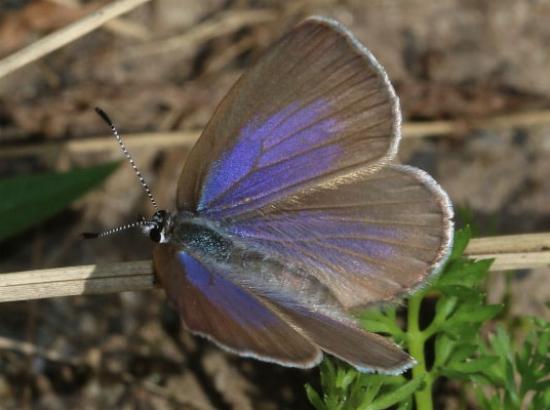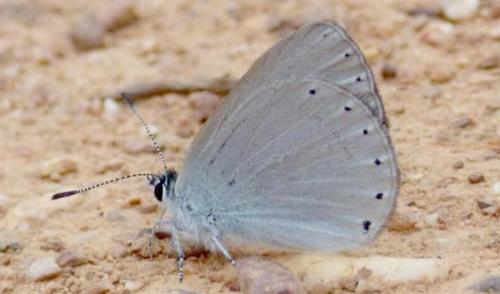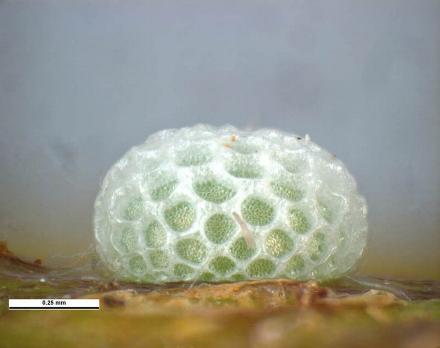
male, subspecies heathi
(Photo: courtesy of
Martin Purvis, taken at Ingleburn, New South Wales)
This Caterpillar is green with dense white hairs,
and six reddish nobs on its back.
It is usually attended by a number of black ants.
It hides by day, and feeds by night on a variety of plants including :
Emu Bush, ( Eremophila longifolia,
MYOPORACEAE ),
Plantains ( Plantago,
PLANTAGINACEAE ),
Derwent Speedwell ( Derwentia derwentiana,
SCROPHULARIACEAE ), and
Riceflower ( Pimelea,
THYMELAEACEAE ).
The caterpillars grow to a length of about 1.5 cms.
The pupa is brown and rough,
with a length of about 1 cm.
It is formed either on the foodplant
or in the ground debris nearby.

female, subspecies heathi
(Photo: courtesy of
Martin Purvis, taken at Ingleburn, New South Wales)
The adults are pale brown on top, with a purple sheen,
and pale veins.
The female has a brighter sheen than the male.
Underneath, they are white with a row of black dots
along the wing margins.
The butterflies have a wing span of about 3 cms.

showing underside
(Photo: courtesy of Eileen Collins, Chiltern, Victoria)
The butterfly is more often encountered in the open fields than the dense forest.
It prefers to remain close to the ground.

egg, magnified
(Photo: courtesy of
Ken Walker, Sydney, New South Wales)
The eggs are pale green, flattened spheres,
covered in a white polygonal net.
The eggs have a diameter of about 0.8 mm.
They are laid singly usually in the axil of a leaf.
The species is thought to occur as several races including:
aeratus (Montague, 1914),
alpina Waterhouse, 1928,
doddi Burns, 1948, as well as
heathi.
over mainland Australia, including
Western Australia,
Northern Territory,
Queensland,
New South Wales,
Victoria,
South Australia.
The population of Candalides heathi
from western Victoria, previously referred to as the ‘Wimmera form’
was recognised in 2004 as a separate species :
Candalides noelkeri.
Further reading :
Michael F. Braby,
Butterflies of Australia,
CSIRO Publishing, Melbourne 2000, vol. 2, pp. 772-774.
H. Ramsay Cox,
Entomological notes from South Australia,
The Entomologist, conducted by Edward Newman,
Volume 6 (1873), p. 402, No. 1.
(updated 10 september 2009, 1 November 2013, 5 August 2020, 5 September 2021)









